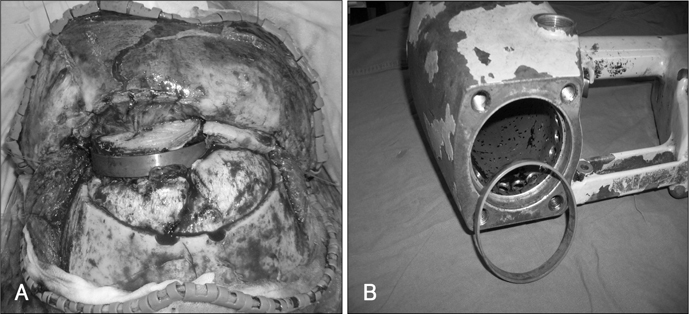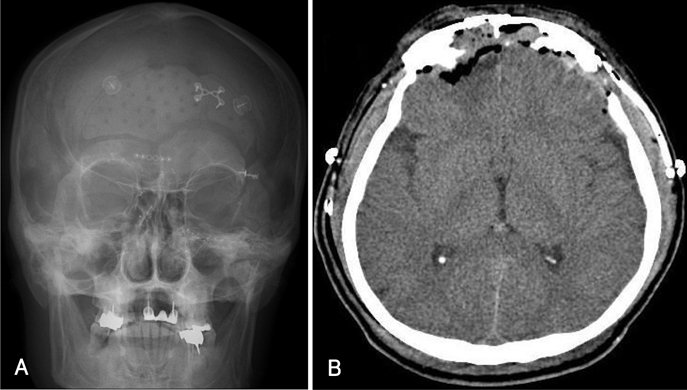J Korean Neurotraumatol Soc.
2009 Dec;5(2):103-105. 10.13004/jknts.2009.5.2.103.
Penetrating Orbitocranial Metallic Foreign Body Injury: A Case Report
- Affiliations
-
- 1Department of Neurosurgery, Dong-A University College of Medicine, Busan, Korea. kukim@daunet.donga.ac.kr
- KMID: 1427367
- DOI: http://doi.org/10.13004/jknts.2009.5.2.103
Abstract
- Penetrating orbitocranial injury caused by metallic foreign body is uncommon and often cause serious damage without prompt treatment. We present our experience with penetrating orbitocranial injury caused by metallic foreign body and review the outcome of surgical management and prognosis. We report a case of a 52-year-old man who presented with penetrating orbitocranial injury caused by metallic foreign body on his left periorbital area. Artifacts caused by the penetrating metal ring on computed tomography (CT) obscure the actual brain damage along the path of penetration. The patient deteriorated in the emergency room and subsequently received surgical intervention. The present report indicates that good result can be achieved by early diagnosis of intracranial injury and by the removal of foreign body. Based on this experience, we recommend prompt surgical intervention with early CT evaluation to determine the extent of brain damage and surrounding damages.
Keyword
Figure
Reference
-
1. Bakir A, Temiz C, Umur S, Aydin V, Torun F. High-velocity gunshot wounds to the head: analysis of 135 patients. Neurol Med Chir (Tokyo). 2005; 45:281–287.
Article2. Chibbaro S, Tacconi L. Orbito-cranial injuries caused by penetrating non-missile foreign bodies. Experience with eighteen patients. Acta Neurochir (Wien). 2006; 148:937–941.
Article3. Davis GA, Holmes AD, Kulg GL. Delayed presentation of transorbital intracranial pen. J Clin Neurosci. 2000; 7:545–548.
Article4. Gönül E, Erdoğan E, Taşar M, Yetişer S, Akay KM, Düz B, et al. Pene-rating orbitocranial gunshot injuries. Surg Neurol. 2005; 63:24–30.5. Kim TW, Lee JK, Moon KS, Kwak HJ, Joo SP, Kim JH, et al. Penetrating gunshot injuries to the brain. J Trauma. 2007; 62:1446–1451.
Article6. Lin HL, Lee HC, Cho DY. Management of transorbital brain injury. J Chin Med Assoc. 2007; 70:36–38.
Article7. Mataró M, Jurado MA, García-Sánchez C, Barraquer L, Costa-Jussá FR, Junqué C. Long-term effects of bilateral frontal brain lesion: 60 years after injury with an iron bar. Arch Neurol. 2001; 58:1139–1142.8. Nathoo N, Boodhoo H, Nadvi SS, Naidoo SR, Gouws E. Transcranial brainstem stab injuries: a retrospective analysis of 17 patients. Neurosurgery. 2000; 47:1117–1122.
Article9. Rahman NU, Jamjoom A, Jamjoom ZA, Abu el-Asrar A. Orbitocranial injury caused by penetrating metallic foreign bodies: report of two cases. Int Ophthalmol. 1997; 21:13–17.10. Salar G, Costella GB, Mottaran R, Mattana M, Gazzola L, Munari M. Multiple craniocerebral injuries from penetrating nails. Case illustration. J Neurosurg. 2004; 100:963.11. Seex K, Koppel D, Fitzpatrick M, Pyott A. Trans-orbital penetrating head injury with a door key. J Craniomaxillofac Surg. 1997; 25:353–355.
Article




